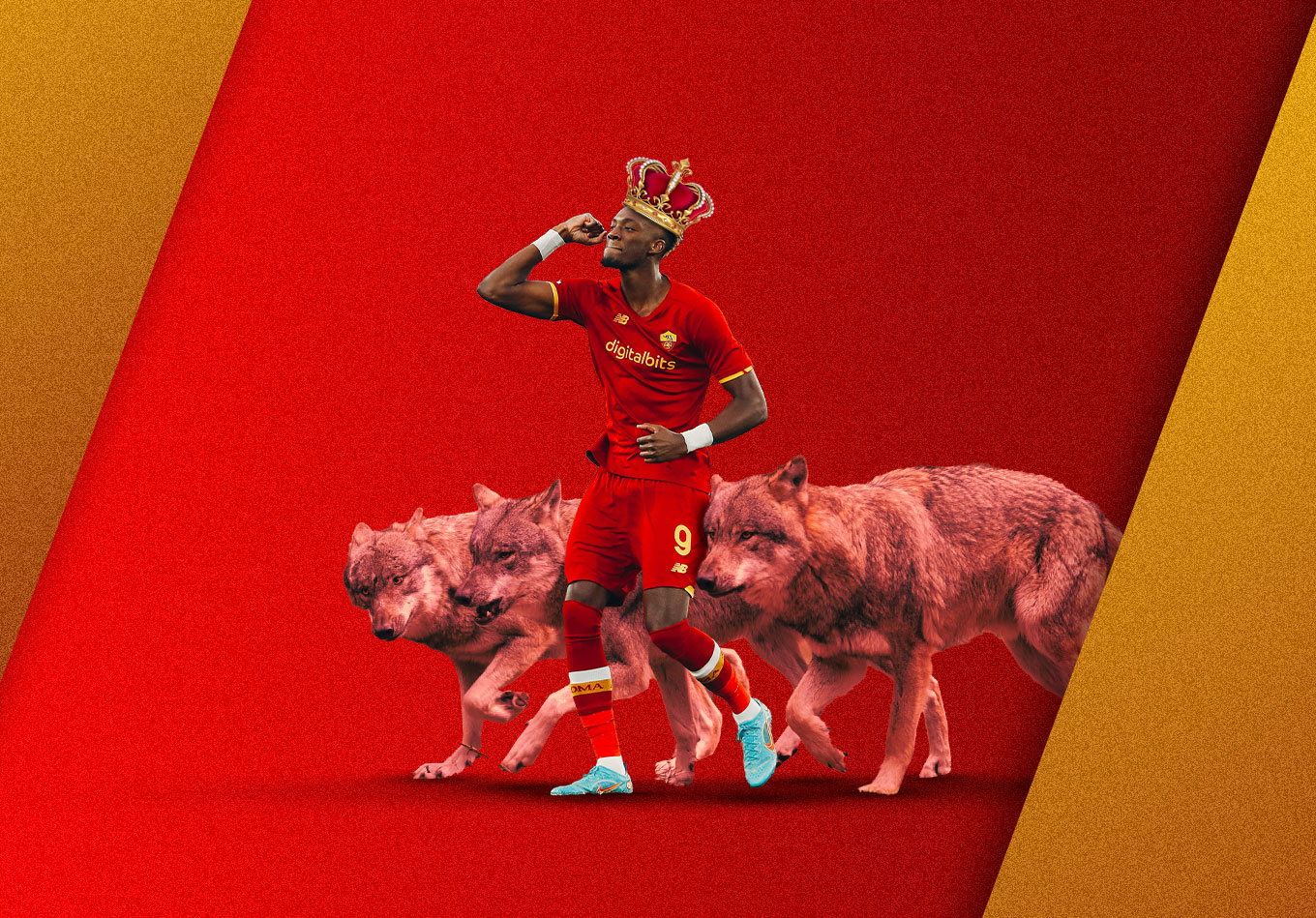Chelsea, despite their prolific Cobham academy, had lacked classic academy-to-first-team success stories. But Tammy Abraham looked poised to be the protagonist of a storyline like this for Chelsea. He joined the club at the under-8 level and worked his way up the levels of youth football, impressing at every step. Then, as all Cobham graduates do, Abraham joined the ranks of Chelsea’s loan army and made the leap, having two 20-plus-goal seasons in the EFL Championship. In 2019, with the striker pecking order clear for him at Chelsea with their transfer ban and the club on the cusp of placing a greater emphasis on the academy under Frank Lampard, things were looking bright for Abraham.
It didn’t end up working out. Despite his impressive 0.6 goals per 90 minutes in the league in the 2019-20 season, the end of Chelsea’s transfer ban saw the club bringing in Timo Werner and Kai Havertz, both established names who are probably best suited to playing as centre-forwards, for big money. This saw Abraham’s playing time reduce substantially, playing only 45.5% of the total available minutes across all competitions in the first half of the 2020-21 season. Then, when Lampard was replaced with Thomas Tuchel, Abraham was side-lined even further, presumably as a result of his perceived issues with link-up play, and ended the season being used for just 30% of available minutes.
“He was clearly not happy with the last half a year” said Tuchel in August 2021, “and maybe he has reason also not to be happy. Maybe it was also my fault not to push him, not to trust him on the same level I maybe trusted other players.”
A defining moment was when Abraham didn’t even make the 12-player bench for Chelsea’s Champions League final. Then, when Chelsea broke their club transfer record to re-sign Romelu Lukaku to lead the line, it didn’t look like there was a way back into being Chelsea’s top choice for Abraham.
Nearly 10 months and a transfer after that Champions League final, however, things look very, very different for Abraham, with a new set of fans.
TAMMY ABRAHAM 🔥🔥🔥 pic.twitter.com/msqJN9Q8pd
— Adriano Del Monte (@adriandelmonte) March 20, 2022
Winning crucial local derbies, pumping up the crowd mid-game, singing club anthems with fans, and outdoing club legends’ records in his debut season, Abraham has quickly become a fan favourite for AS Roma, after his move in a deal that cost Roma a reported £34 million. He’s scored 15 goals (13 non-penalty goals) in Serie A so far, the joint third-highest in the league.
Abraham’s speedy success has come as a surprise for quite a few, considering how recently he was a third- or fourth-choice striker for Chelsea. Let’s dig deeper into what’s behind such a prolific season so far.
Goalscoring
First off, Abraham has always been a great scorer of goals. Apart from his season on loan at a struggling Swansea City in 2017-18, he’s scored 0.5 non-penalty goals per 90 minutes in every senior season he’s played. This goal tally at Roma of 15 so far in the season in the league is nothing surprising, considering that he’d already matched the tally for Chelsea in 2019-20 with fewer minutes and with no penalty goals. As much as I’d love to work in a silly line about a renaissance in Italy, Abraham’s success at Roma has more to do with continuity than substantial improvement.
Abraham’s underlying expected goals (xG) numbers have always been impressive, generally matching or exceeding his actual goal numbers every season. His shot volume has averaged at a healthy three shots p90 throughout his career, but the more striking aspect is his shot quality. From the very start of his senior career, Abraham has taken high-quality chances from great scoring positions, across different levels of team quality. Just look at how many come from the central areas of the box, or the ‘danger zone’.
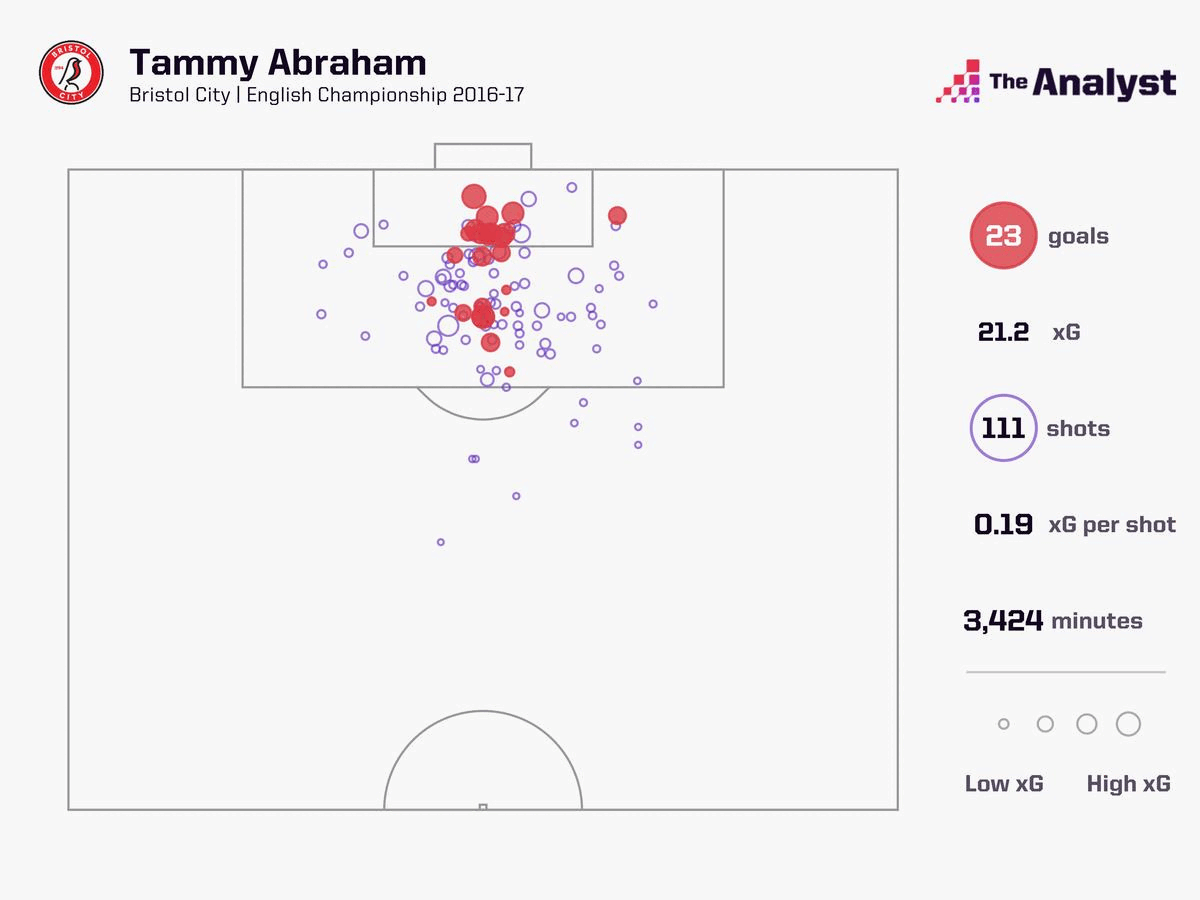
This continues to be the case at Roma.
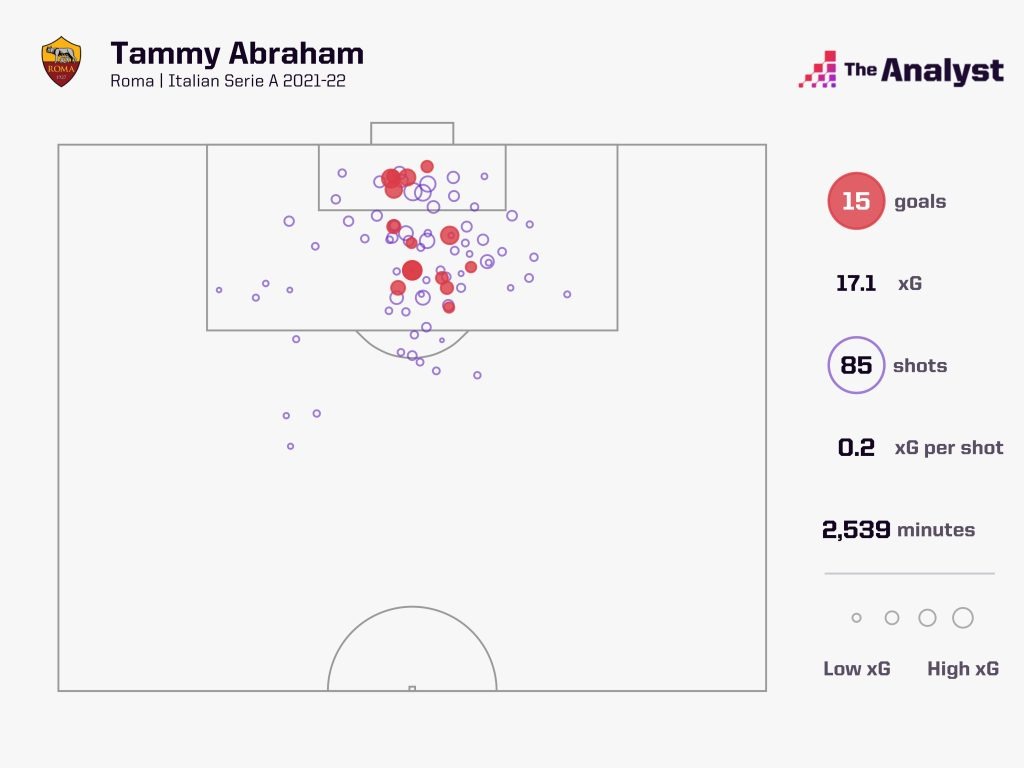
His ability to create great chances for himself comes from what’s arguably his biggest strength, his movement. Good movement and positioning off the ball are the bread-and-butter of any good goalscorer’s game, and it’s been a constant feature of Abraham’s from the very start. It’s also clear how great an emphasis Abraham places on movement off the ball. “When I’m playing against a top striker,” he says in a video discussing his favourite strikers, “I do watch the little things, for example, their movement, where they position themselves, where they are in the box, their timings to get into the box, etc. Me, I take them little ideas and try to add it to mine [his game].”
What’s more, his movement is very well-suited to direct, transition-based attacking. And Roma is very much a José Mourinho side, with how direct they are for a big side and with their counter-attacking prowess. With Roma’s attack moving forward at 1.66 metres per second, they’re one of the fastest attacks in the league, and no side in the league has more fast breaks – a proxy for tracking counter-attacks – than them.
Abraham, who generally starts high up the pitch, between two defenders in the backline and making runs off the shoulder, is a good fit to an attack that tries to get forward quickly. A statistical indicator of this high starting position is the high percentage of his passes that he receives in and around the penalty area.
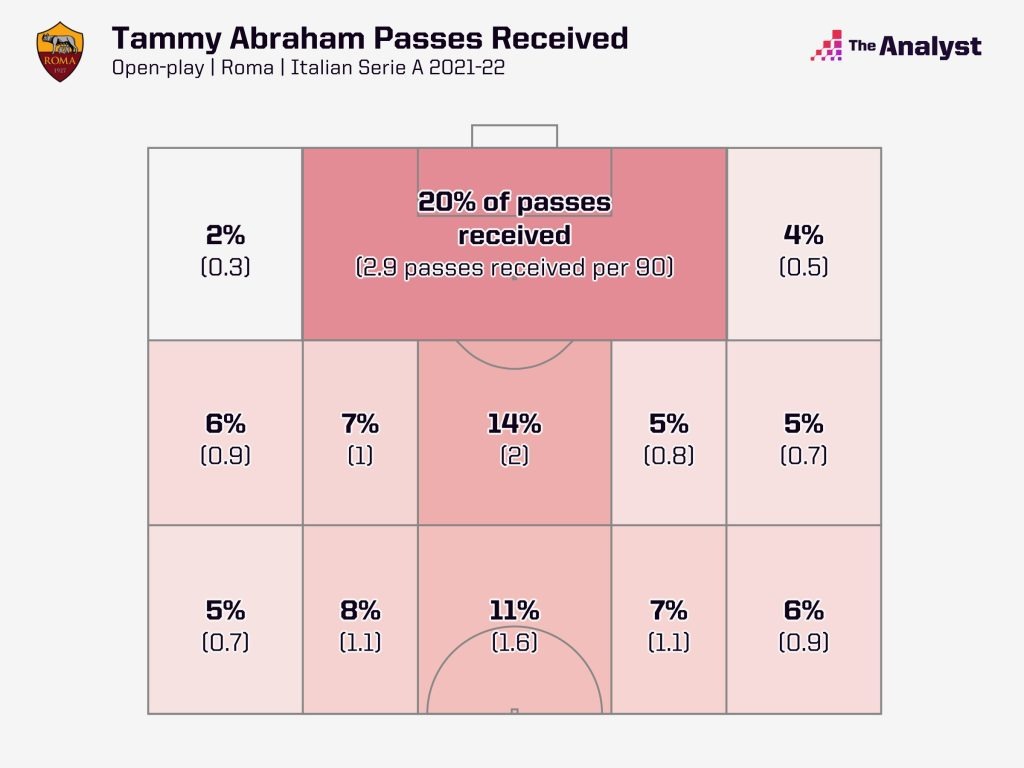
By the looks of it, Abraham, like most players who excel at off-ball movement, uses double-movements (faking a run towards one side and then moving the other way) and changes in speed and direction well to lose the marker and find space for himself. A recent example is in this attack against Spezia, where he starts from the left of the opposition centre-back and moves to the right, away from the ball and dragging the centre-back along…
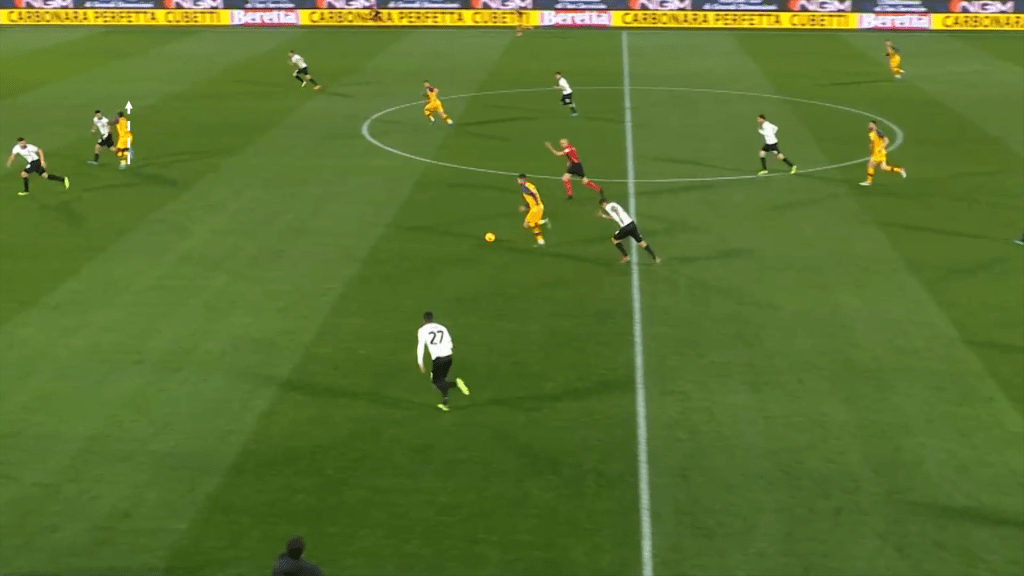
…and then moves back to the left, into acres of space, but unfortunately, Lorenzo Pellegrini doesn’t make the pass and opts to shoot instead.
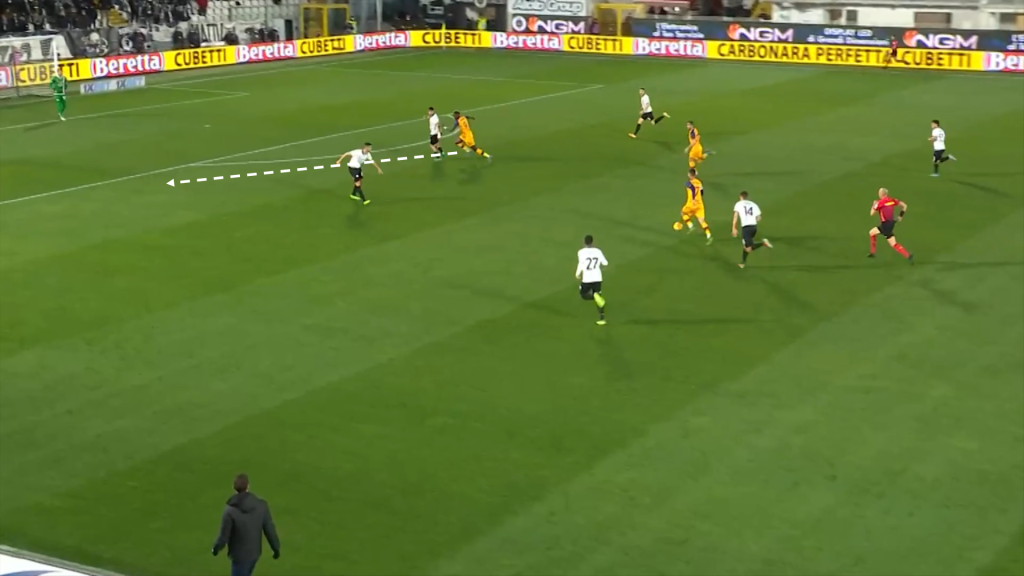
Moreover, Abraham tends to pick the right positions and fills the right spaces in attack. In counter-attacks, he usually runs the right channels and is comfortable moving out wide to find space, particularly when playing alongside Nicolò Zaniolo in the 3-4-1-2 that Mourinho has used more in recent games. Here’s an example in a counter-attack, where he drags out a defender with a run out wide, creating space centrally for Zaniolo to run into…
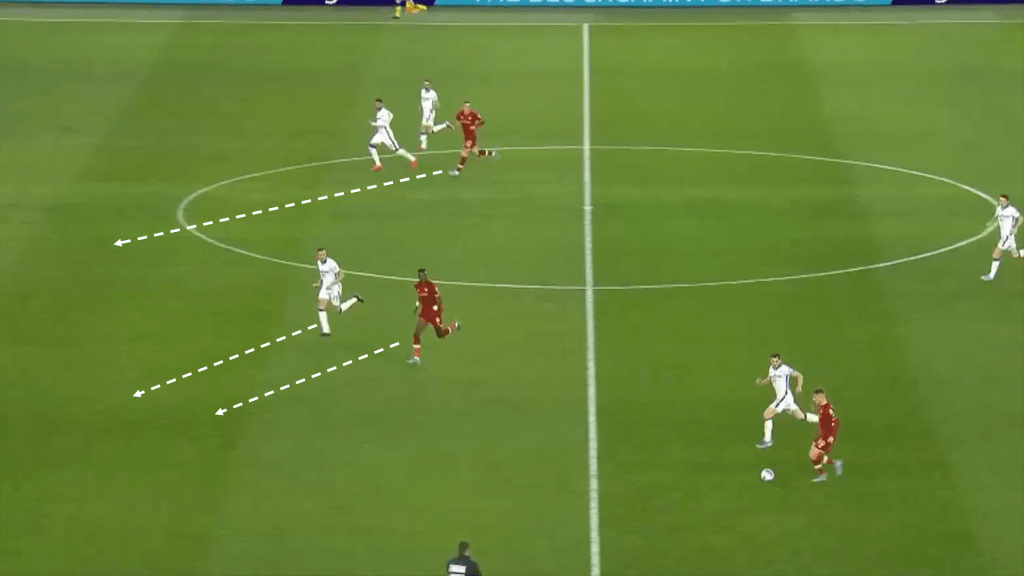
…and then moves back centrally into free space to create a passing option for Zaniolo.
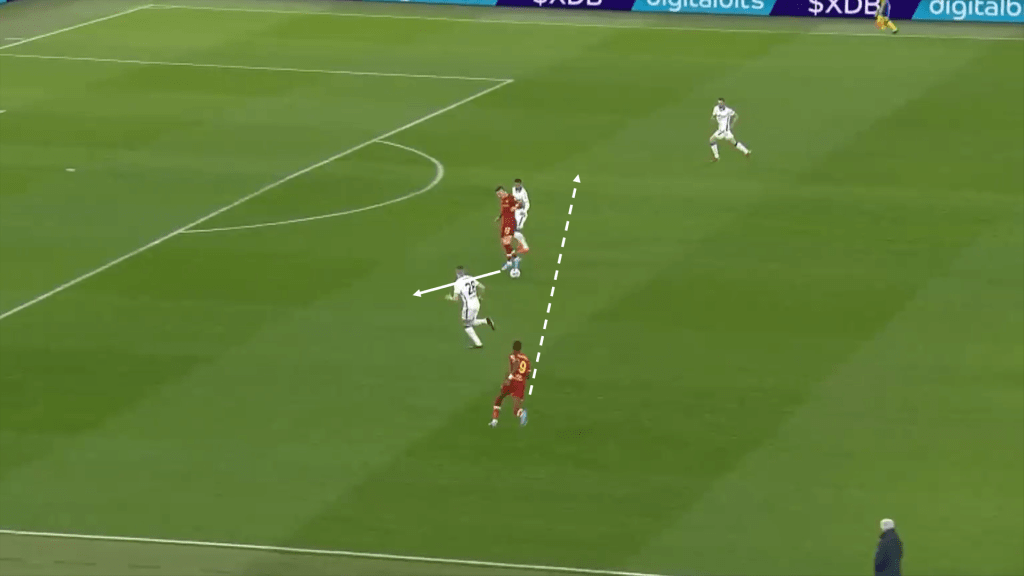
Abraham also seems occasionally comfortable moving in from wide areas, using defenders’ blind spots, like in the goal at 0:50 here:
Roma are also a side that create many chances from crosses and cut-backs, creating 3.3 shots per game directly from crosses, the third-highest in the league, and Abraham is a great threat from crosses with his double-movements and changes in speed. He often starts on the far-side of the farthest centre-back from the ball, pulling the defender further wide and creating space for him to attack, and then when the delivery comes in, he quickly changes direction and makes the run towards the ball on the defender’s other side, in space.
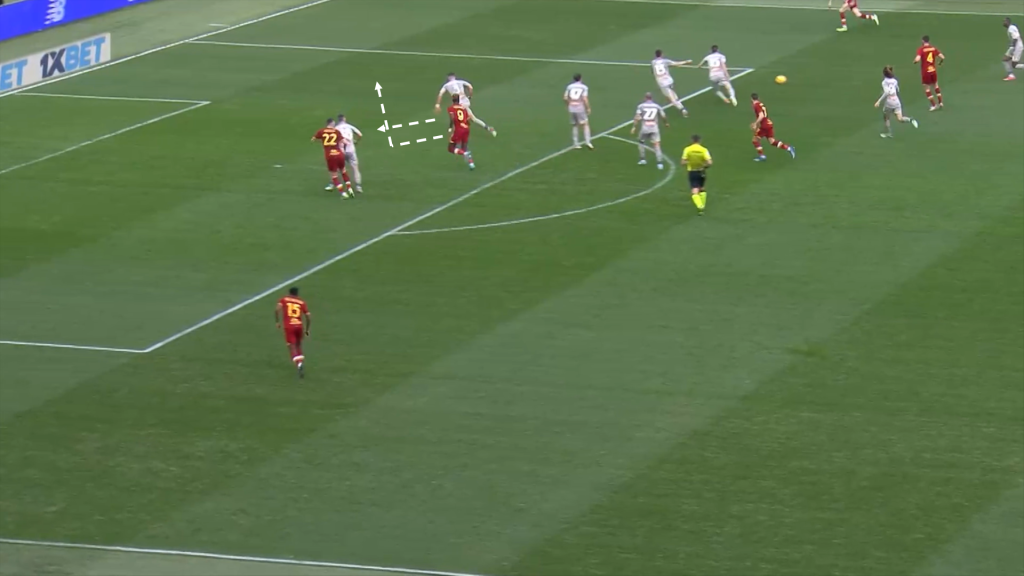
Aside from his movement, Abraham has also shown the ability to consistently turn touches into shots. 48% of his touches in the box lead to shots. An example is this goal in Roma’s cup tie with Lecce.
Need more cup inspiration like this from Tammy tonight!
— AS Roma English (@ASRomaEN) February 8, 2022
#ASRoma | @tammyabraham pic.twitter.com/WCyIBXqJK2
Or like in this goal, against Salernitana.
Just 2⃣ days and we are back in action!
— AS Roma English (@ASRomaEN) September 10, 2021
#ASRoma | @tammyabraham pic.twitter.com/10KlymWO13
Abraham has also shown good ball retention, creating shots from difficult situations, like with this goal.
🔥 TAMMY | 𝙏𝙒𝙀𝙉𝙏𝙔 ⚽️
— AS Roma English (@ASRomaEN) March 7, 2022
Another match-winner for the No. 9 – his 20th goal of the season so far!#ASRoma | @tammyabraham pic.twitter.com/pgpjWBsU84
All in all, finding space off the ball is seemingly Abraham’s stand-out skill, and while he’s great at getting chances for himself in different systems and playing with varying levels of quality, his skillset is very well-suited to Roma’s tactical setup.
Passing, Creativity, and Link-up Play
Abraham’s lack of creativity in the conventional sense and his general weaknesses with link-up play has usually been the primary critique levelled at him. With his high starting position, he’s remained rather uninvolved in general play for a modern striker, averaging just 12.4 accurate passes p90 over the course of his senior career. This is likely to have been why Tuchel preferred Werner and Havertz to Abraham upfront, despite the two Germans’ struggles in front of goal.
However, in a faster, more direct side like Mourinho’s Roma, direct involvement in link-up play is less crucial. Plus, Abraham is proficient with the kind of creative involvement that helps oil the wheels of Roma’s attacking machine.
Firstly, for Roma, it looks like Abraham’s been executing one-touch flick-on passes and layoffs well, while being challenged. This makes him a great outlet for Roma’s counter-attacks, and many of their successful attacks wouldn’t exist without his contribution.
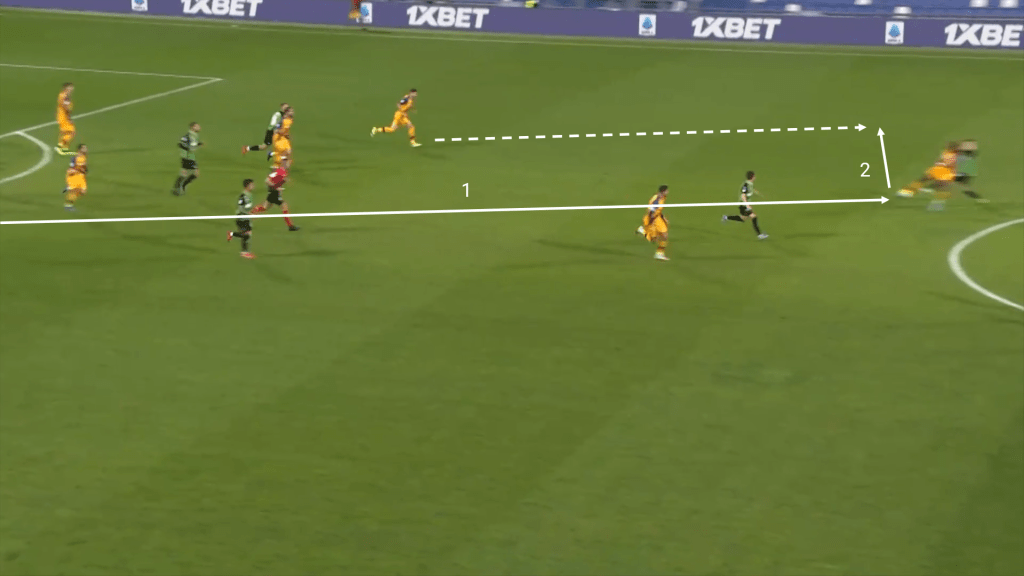
Secondly, he also occasionally releases players into space in transition well, with longer passes over the top.
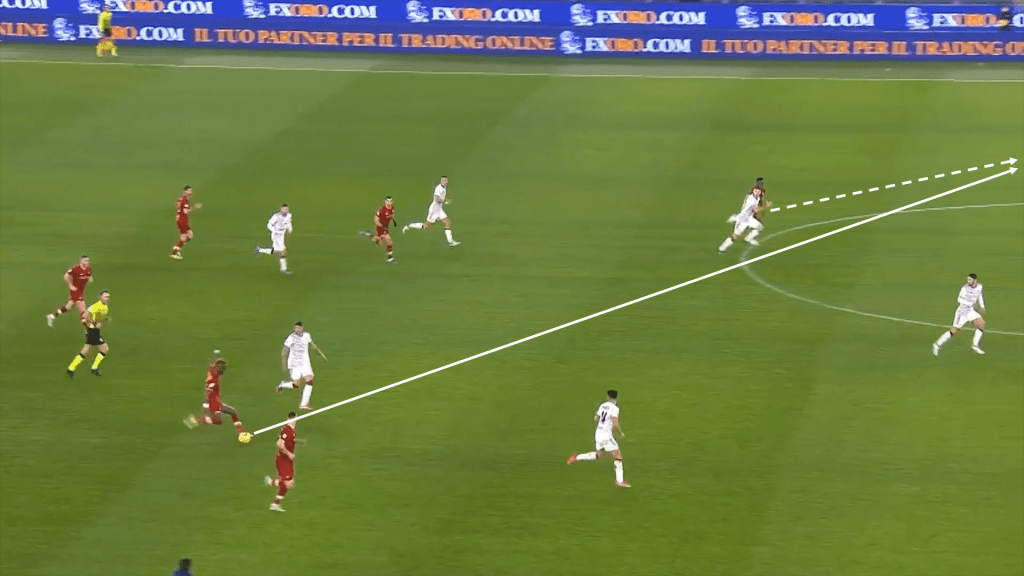
Creativity, of course, is much more than just passing, and much more than what simple or advanced on-ball stats can quantify, and this is where Abraham excels. Firstly, his movement helps stretch the backline and occupy defenders, creating space for attacking midfielders. Even if he receives and plays only a few passes every game, his off-ball contribution leads to him creating space and opportunities for his teammates to use. Here’s an example against Torino, where he pins back Alessandro Buongiorno to create space for Zaniolo’s decoy run, which then in turn creates space for Abraham to score.
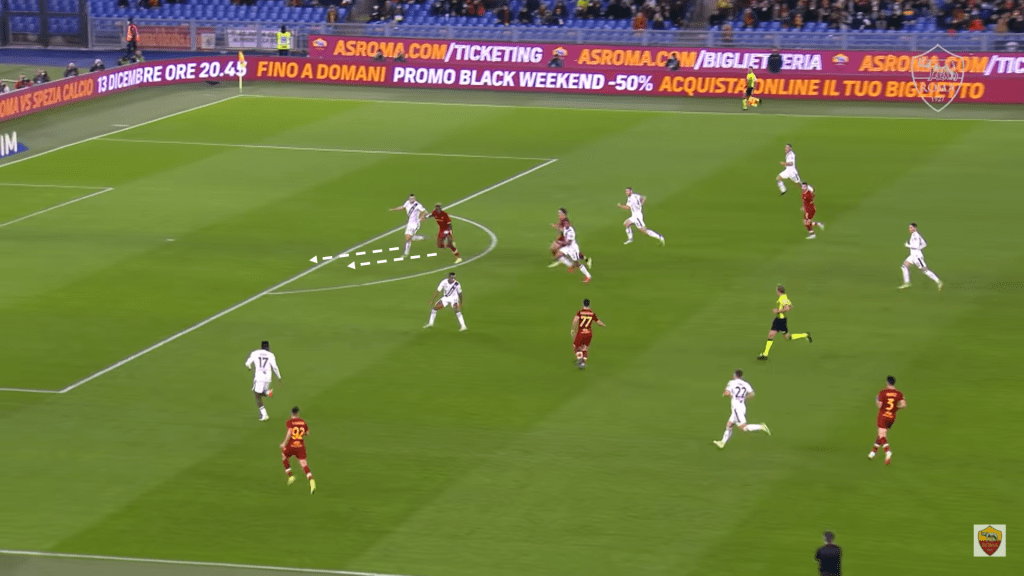
Mourinho pointed out Abraham’s value in stretching play in the press conference after the striker’s debut against Fiorentina. “I was thinking about Fiorentina’s high press,” he said, “and thought we needed a striker who could push them back. Tammy was perfect.”
Secondly, Abraham drags out defenders with his movement, and creates good chances for his teammates by making decoy runs. Roma’s last two goals, at 1:30 and at 1:46 in the video here, against Empoli in their 4-2 win are good examples of Abraham’s decoy runs (and in the second of the two goals, another example of his value as a counter-attacking outlet) helping create goals for his teammates, even if he doesn’t get an assist to his name for either goal.
On the whole, while Abraham has shown deficiencies in his link-up play before, especially with his passing weight and while under pressure from behind against set defences, he’s a big positive in possession in Roma’s setup. In addition, he creates lots of opportunities for Roma without touching the ball, too, and this is something that goes under the radar while being very, very valuable for any side.
Pressing and Defensive Contribution
Abraham has always been a decent contributor in pressing and in tracking back, like most young strikers in the age that demands defensive contribution from strikers. While Mourinho’s Roma don’t press the opposition’s build-up as much, with the seventh-lowest high turnovers (possession wins within 40 metres of the opposition’s goal) and the ninth-highest PPDA (passes allowed per defensive action; a lower PPDA means a more intense high press) in the league, Abraham contributes well to winning the ball back. He attempts more tackles now at Roma (1.3 p90) than he ever did before in his career, and his defensive contribution goes beyond the times he directly wins possession back himself.
It looks like Abraham closes down the defender with the ball with curved movement, cutting off passes to central midfield and forcing riskier passes out wide or down the line. He also seems to aggressively press opposition defenders who have the ball deep and wide in their own half, cutting off angles well. Here’s an example against Spezia, where he wins the ball wide in the opposition’s half.
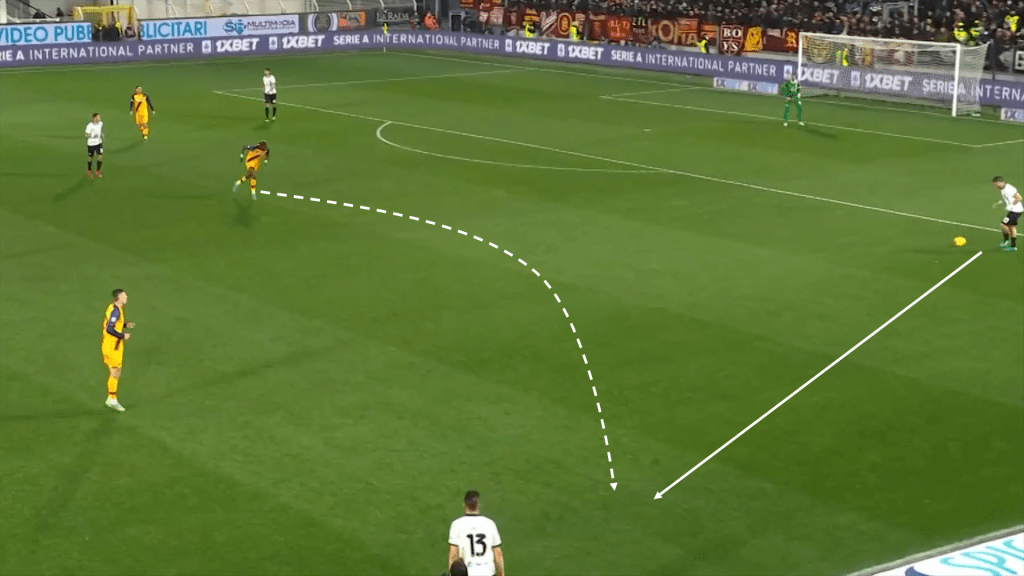
Abraham is also diligent at tracking back. A particularly memorable recent example was when Felipe Anderson seemed ready to start a counter-attack for Lazio in the derby with his carry after recovering the ball, before Abraham quickly chased Anderson to the half-way line, put a challenge in, and won the foul, prompting a big cheer from the crowd. In summary, Abraham contributes to more than just the attacking side for Roma.
Conclusion
A lot of discussion in English-speaking realms about Abraham’s performances at Roma seems to revolve around the change in leagues. It is undeniably true that there is a growing gap between the Premier League and the other big leagues financially and, as a result, quality-wise, and that Serie A has been the league that sees the most goals for some time, but I think differences in difficulty between the very best leagues are overrated, and subject to dated clichés about national playing styles. Moreover, not only has Abraham previously scored at a higher rate in the Premier League in 2019-20, but Roma being a less dominant side in Serie A than Chelsea are in the Premier League adds another layer. For most players but especially in Abraham’s case, team effects are likely to have a bigger role than league effects.
And as we’ve discussed, Roma’s more direct attack seems to suit Abraham’s skillset, accentuating his strengths and decreasing the effects of his weaknesses. It’s likely to explain why Abraham’s performances outside the goals look more impressive this season. That being said, systems and players don’t have a linear, one-way effect, either. The system does help Abraham, but Abraham helps facilitate Roma’s attacking system, too, when he stretches defences, occupies and pins defenders, sets up counter-attacks, and makes decoy runs to create space for his teammates.
Inevitably, the Premier League top six is likely to come knocking, and there’ll be questions on whether he can be the starting striker for a high-possession side. But Abraham’s skillset is of immense value to any side playing in any tactical system as someone who attacks space and stretches play, and very few players approaching their peak can best his goalscoring qualities. Either way, though, for now, he seems at home at Roma, and it’s thrilling to see just how far he can go.
Enjoy this? Subscribe to our newsletter to receive exclusive content.
Banner design by Matt Sisneros.
